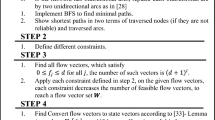Abstract
Computer and communication applications such as big data analytics services, social networks, enterprise business and mobile applications often require to simultaneously pass data of different sizes between multiple source and multiple destinations in the network. In practice, the nodes in the communication networks are often connected through multiple intermediate links of different types with varying failure probabilities. Failure of intermediate links can adversely affect data transmission between source and destination nodes; thus, they can impact the quality of service. Therefore, reliability evaluation of such networks is of subtle importance in today’s service dependent world. This article presents an efficient method for reliability evaluation of stochastic flow networks that can pass various demands simultaneously from multiple source nodes to multiple destination nodes. The proposed method has three steps: First step obtains the combined minimal cut sets between the given set of source and destination nodes. Second step generates the set of simultaneous upper boundary flows for the varying demands using the combined minimal cut sets. Third step calculates the network unreliability by applying the Sum of Disjoint Product method on the upper boundary flows. The reliability of the network, i.e., the probability that the network can simultaneously pass the set of demands, is calculated as 1-Unreliability. The MATLAB simulation of the proposed method on bench mark networks show that the proposed approach takes less computational time than the existing method.





























Similar content being viewed by others
References
Ball MO (1980) Complexity of network reliability computations. Networks 10:153–165
Barlow RE, Wu AS (1978) Coherent systems with multi-state components. Math Oper Res 3:275–281
Block HW, Savits TH (1982) A decomposition for multistate monotone systems. J Appl Probab 19:391–402
Chakraborty S, Goyal NK (2017) An efficient reliability evaluation approach for networks with simultaneous multiple-node-pair flow requirements. Qual Reliaby Eng Int 33:1067–1082
Chandrasheker T, Goyal N (2013) An approach to evaluate multiple node pair reliability for simultaneous capacity requirements. Int J Perform Eng 9:357–366
Chen SG, Lin YK (2012) Search for all minimal paths in a general large flow network. IEEE Trans Reliab 61:949–956
Datta E, Goyal NK (2017) Sum of disjoint product approach for reliability evaluation of stochastic flow networks. Int J Syst Assur Eng Manag 8:1734–1749
El-Neweihi E, Proschan F, Sethuraman J (1978) Multistate coherent systems. J Appl Probab 15:675–688
Ford LR, Fulkerson DR (1962) Flows in networks. Princeton University Press, Princeton
Forghani-elahabad M, Mahdavi-Amiri N (2016) Reliability assessment of a multi-source multi-sink stochastic-flow network in terms of minimal paths. In: Proceeding of 9th international iranian operation research conference, pp 1065–1069
Griffith WS (1980) Multistate reliability models. J Appl Probab 17:735–744
Lin YK (2002a) Overall-terminal reliability of a stochastic capacitated-flow network. Math Comput Model 36:173–181
Lin YK (2002b) Using minimal cuts to evaluate the system reliability of a stochastic-flow network with failures at nodes and arcs. Reliab Eng Syst Saf 75:41–46
Lin YK (2010) Reliability evaluation for overall-terminal multistate flow networks with bi-directed arcs. Expert Syst Appl 37:6669–6674
Lin Y-K, Huang C-F (2013) Stochastic computer network under accuracy rate constraint from QoS viewpoint. Inf Sci 239:241–252
Lin YK, Yeng LCL (2013) Network reliability based decision of Internet with multiple sources and multiple sinks. Decis Support Syst 54:1477–1487
Lin YK, Yuan J (2003) Flow reliability of a probabilistic capacitated-flow network in multiple node pairs case. Comput Ind Eng 45:417–428
Mishra R, Chaturvedi SK (2009) A cutsets-based unified framework to evaluate network reliability measures. IEEE Trans Reliab 58:658–666
Author information
Authors and Affiliations
Corresponding author
Additional information
Publisher's Note
Springer Nature remains neutral with regard to jurisdictional claims in published maps and institutional affiliations.
Rights and permissions
About this article
Cite this article
Datta, E., Goyal, N.K. Evaluation of stochastic flow networks susceptible to demand requirements between multiple sources and multiple destinations. Int J Syst Assur Eng Manag 10, 1302–1327 (2019). https://doi.org/10.1007/s13198-019-00876-9
Received:
Revised:
Published:
Issue Date:
DOI: https://doi.org/10.1007/s13198-019-00876-9




